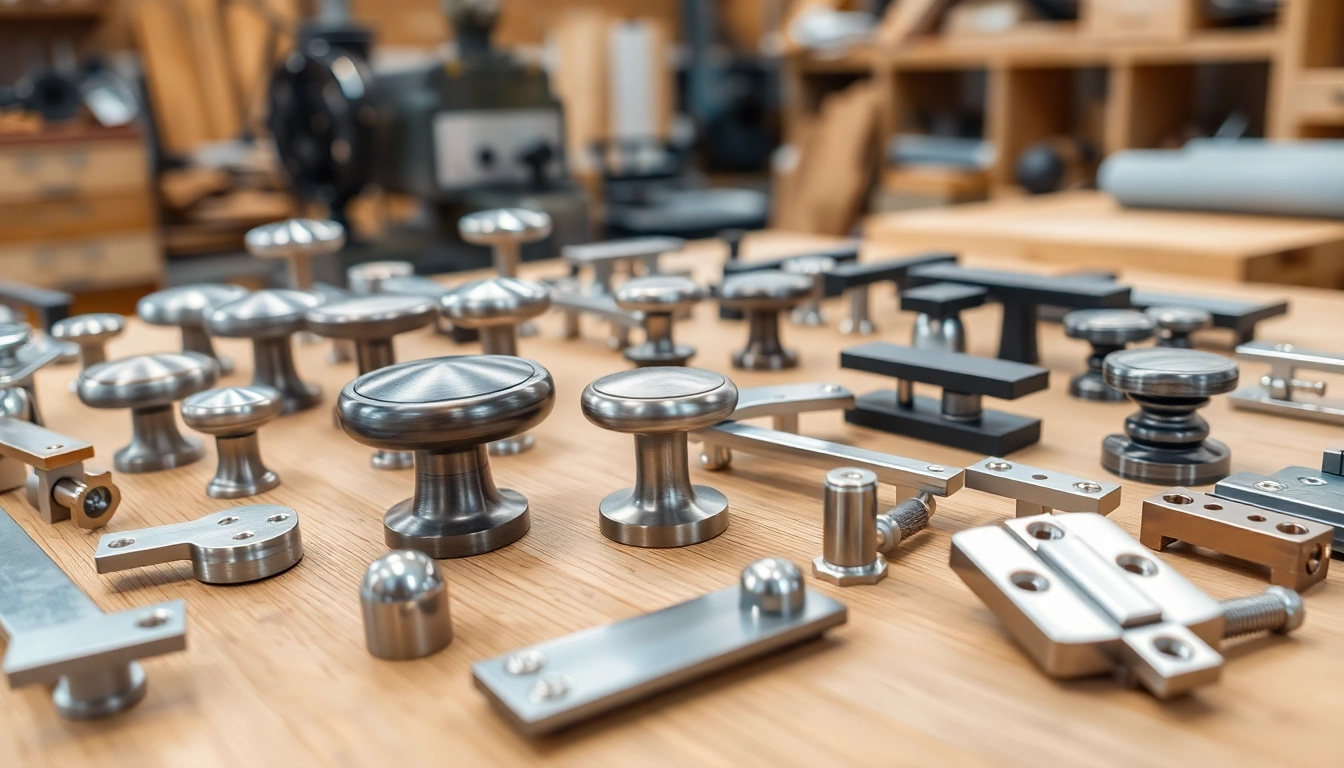Understanding the Role of Furniture Hardware Manufacturers
In the vast landscape of home furnishings, furniture hardware manufacturers play a pivotal role. These are the companies responsible for producing the various components that enhance functionality and style in furniture construction and renovation. From hinges and locks to knobs and pulls, furniture hardware influences both the aesthetic and practical aspects of furniture. Understanding the nuances of this industry can empower consumers, manufacturers, and designers alike in making informed decisions about their projects.
What Are Furniture Hardware Manufacturers?
Furniture hardware manufacturers specialize in the design and production of mechanical components necessary for assembling and operating furniture. They create a wide array of products, including:
- Hinges: Essential for doors and cabinets, allowing seamless opening and closing.
- Drawer slides: Enabling smooth movement for drawers, available in various styles such as undermount and side mount.
- Cabinet locks: Providing security for storage spaces.
- Knobs and pulls: Vital for user interface in cabinets and drawers.
- Specialty hardware: Items like tray slides, lift mechanisms, and furniture legs.
These manufacturers not only supply components but also often offer innovative solutions, contributing to the overall development of furniture design trends.
The Importance of Quality in Furniture Hardware
When it comes to furniture hardware, quality isn’t just a preference; it’s a necessity. Quality hardware ensures durability, functionality, and reliability. Low-quality hardware can lead to various issues, such as:
- Failure to operate correctly, leading to frustration and potential repairing costs.
- Shortened lifespan of furniture, necessitating early replacements.
- Unsafe conditions, especially with heavy or intricate pieces where hardware failure could cause injury.
Investing in quality furniture hardware is essential for both consumers and manufacturers who wish to maintain their reputation and provide long-lasting solutions.
How to Identify Reliable Manufacturers
Finding a trustworthy furniture hardware manufacturer involves considering several factors, including:
- Reputation: Look for manufacturers with a strong track record and positive reviews within the industry.
- Certifications: Quality certifications such as ISO can indicate adherence to quality management systems.
- Product Range: A manufacturer that offers a wide array of products often indicates experience and investment in R&D.
- Customer Service: Reliable manufacturers should provide good support and clear communication for their customers.
Networking within industry forums and participating in trade shows can also provide insights into the best manufacturers available.
Types of Furniture Hardware Products
The diversity in furniture hardware products is largely driven by consumer needs and trends within the furniture industry. Here are some popular types:
Popular Products from Leading Manufacturers
Some of the most sought-after products in the market include:
- Soft-close hinges: These prevent doors from slamming, enhancing safety and user experience.
- Drawer slides with full extension: Allowing drawers to open completely for better accessibility.
- Decorative knobs and pulls: Serving as both functional components and design elements, available in various styles from vintage to modern.
Manufacturers like Top Knobs and Rockler offer extensive catalogs of these products, catering to diverse tastes and project requirements.
Innovative Designs and Trends in Furniture Hardware
Design trends are constantly evolving, influenced by technological advances and consumer preferences. Current trends include:
- Minimalistic designs: Hardware that integrates seamlessly into furniture.
- Smart hardware: Innovations facilitating smart home integration, allowing remote locking/unlocking features.
- Eco-friendly materials: An increasing demand for sustainable manufacturing practices, using recycled or sustainably sourced materials.
Staying updated with design trends can help both consumers and manufacturers create products that resonate with current aesthetic preferences.
Choosing the Right Hardware for Your Project
Selecting the appropriate hardware for a project involves considering both functional and aesthetic factors:
- Project type: Different furniture types (kitchen cabinets vs. office desks) will require varying hardware solutions.
- Weight capacity: Assessing how much weight the hardware needs to support is crucial for safety and functionality.
- Design compatibility: Ensuring that the chosen hardware complements the overall design of the furniture.
Hardware that aligns with the project goals significantly enhances the end product’s appeal and usability.
Comparing Different Furniture Hardware Manufacturers
Differentiating among furniture hardware manufacturers can be pivotal for making the best procurement decisions. Here’s a breakdown of how to effectively compare them:
Evaluating Manufacturer Reputation in the Industry
Manufacturer reputation is a cornerstone of evaluation. Sources of information can include:
- Industry publications: Read reviews and mentions in industry-relevant magazines and journals.
- Trade shows: Engaging with industry peers can unveil first-hand experiences and recommendations.
- Online forums: Participating in or reviewing discussions in expert forums can provide insights into manufacturers.
A consistent positive reputation typically signifies reliability and commitment to quality.
Pricing Strategies of Top Furniture Hardware Suppliers
When assessing prices, consider not just the upfront cost but also the overall value. Manufacturers may employ various pricing strategies, including:
- Value-based pricing: This considers the perceived value of the product in the marketplace.
- Competitive pricing: Setting prices based on competitor rates to remain attractive to consumers.
- Tiered pricing: Offering different levels of quality and price points can cater to varied consumer budgets.
Understanding these strategies can provide insight into what drives a manufacturer’s pricing model.
Customer Reviews and Testimonials
Customer experiences often provide the most transparent view of a manufacturer’s quality. When evaluating feedback, consider:
- Volume of reviews: A higher volume of reviews can indicate a more reliable consensus.
- Recurrence of issues: Patterns in negative feedback can point to specific areas that need attention.
- This can include: Time taken for delivery, customer service responsiveness, and product performance.
Utilizing multiple review sources, including social media and dedicated review sites, enhances the reliability of this information.
How to Source Furniture Hardware Effectively
Efficient sourcing of furniture hardware can streamline the production process, saving both time and money. Here are methodologies for effective sourcing:
Direct Sourcing from Manufacturers vs. Distributors
Choosing between sourcing directly from manufacturers or via distributors relies on several factors:
- Cost: Direct sourcing can often reduce costs by cutting out middlemen.
- Product variety: Distributors typically carry broader selections and may include products from multiple manufacturers.
- Minimum order quantities: Manufacturers may have higher minimum orders compared to distributors, impacting smaller projects.
Evaluating your project’s scale and needs will inform the best sourcing route.
Best Practices for Bulk Orders
For larger orders, implementing best practices can optimize procurement and resource management:
- Consolidate orders: Combining multiple item orders into a single shipment can minimize shipping costs.
- Negotiate terms: Engaging in discussions about terms and pricing can lead to favorable agreements.
- Plan ahead: Forecasting needs and ordering in advance can mitigate product shortages and production delays.
Establishing solid relationships with providers can also enhance negotiation power and facilitate smoother transactions.
Understanding Shipping and Delivery Considerations
Considering shipping logistics can significantly affect project timelines. Important factors to evaluate include:
- Shipping timeframes: Understanding standard shipping durations can aid in project planning.
- Tracking systems: Access to tracking can enhance transparency and communication.
- Shipping costs: Comparing shipping among various manufacturers can reveal additional hidden expenses.
Addressing these elements can improve the overall efficiency of procurement processes.
Future Trends in Furniture Hardware Manufacturing
The furniture hardware industry is a dynamic field, continuously adapting to new technologies and consumer demands. Here are some anticipated trends that will shape the future:
Embracing Sustainability in Hardware Production
Sustainability is increasingly becoming a priority in many industries, including furniture hardware manufacturing. Key elements include:
- Material selection: Using recycled or sustainable materials can significantly reduce the environmental footprint.
- Energy-efficient processes: Investing in manufacturing processes that minimize energy consumption adheres to eco-friendly practices.
- Lifecycle assessments: Assessing the impact of hardware products throughout their lifecycle promotes responsible production.
Consumers are more inclined to support brands that demonstrate a commitment to sustainability.
Technological Innovations Impacting the Industry
Technology is revolutionizing furniture hardware production in several ways:
- Automation: Automated processes improve production efficiency, reducing lead times and increasing precision.
- Smart technology: Integrating smart features into hardware, like wireless locks or sensors, caters to the growing smart home market.
- 3D printing: Allows for rapid prototyping and customization of hardware designs, enabling manufacturers to innovate swiftly.
These advancements not only enhance functionality but also boost the competitive edge of manufacturers in the market.
Looking Ahead: Predictions for Furniture Hardware Products
As consumer preferences evolve, the furniture hardware industry must adapt. Future predictions may include:
- Personalization: Increasing demand for custom hardware solutions tailored to individual needs.
- Enhanced integration: Products that seamlessly integrate with existing furniture will become more popular as DIY and home improvement activities grow.
- Focus on health and safety: Hardware designed to eliminate risks (like soft-close mechanisms) will likely gain traction.
By recognizing and responding to these trends, manufacturers will be well-positioned to lead in the ever-changing furniture hardware landscape.



